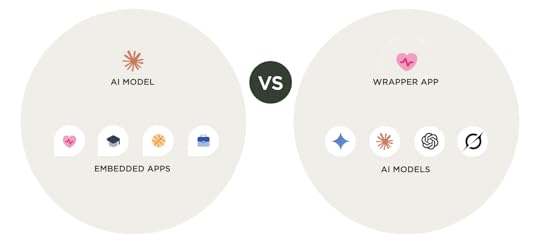Wrapper vs. Embedded AI Apps
As we saw during the PC, Web, and mobile technology shifts, how software applications are built, used, and distributed will change with AI. Most AI applications built to date have adopted a wrapper approach but increasingly, being embedded is becoming a viable option too. So let's look at both...
Wrapper AI Apps
Wrapper apps build a custom software experience around an AI model(s). Think of these as traditional applications that use AI as their primary processing engine for most core tasks. These apps have a familiar user interface but their features use one or more AI models for processing user input, information retrieval, generating output, and more. With wrapper apps, you need to build the application's input and output capabilities, integrations, user interface, and how all these pieces and parts work with AI models.
The upside is you can make whatever interface you want, tailored to your specific users' needs and continually improve it through your visibility of all user interactions. The cost is you need to build and maintain the ever-increasing list of capabilities users expect with AI applications like: the ability to use image understanding as input, the ability to search the Web, the ability to create PDFs or Word docs, and much more.
Embedded AI Apps
Embedded AI apps operate within existing AI clients like Claude.ai or ChatGPT. Rather than building a standalone experience, these apps leverage the host client for input, output, and tool capabilities, alongside a constantly growing list of integrations.
To use concrete examples, if ChatGPT lets people to turn their conversation results into a podcast, your app's results can be turned into a podcast. With a wrapper app, you'd be building that capability yourself. Similarly, if Claude.ai has an integration with Google Drive, your app running in Claude.ai has an integration with Google Drive, no need for you to build it. If ChatGPT can do deep research, your app can ... you get the idea.
So what's the price? For starters, your app's interface is limited by what the client you're operating in allows. ChatGPT Apps, for instance, have a set of design guidelines and developer requirements not unlike those found in other app stores. This also means how your app can be found and used is managed by the client you operate in. And since the client manages context throughout any task that involves your app, you lose the ability to see and use that context to improve your product.
Doing Both
Like the choice between native mobile apps and mobile Webs sites during the mobile era... you can do both. Native mobile apps are great for rich interactions and the mobile Web is great for reach. Most software apps benefit from both. Likewise, an AI application can work both ways. ChatDB illustrates this and the trade-offs involved. ChatDB is a service that allows people to easily make chat dashboards from sets of data.
People can use ChatDB as a standalone wrapper app or embedded within their favorite AI client like Claude or ChatGPT (as illustrated in the two embedded videos). The ChatDB wrapper app allows people to make charts, pin them to a dashboard, rearrange them and more. It's a UI and product experience focused solely on making awesome dashboards and sharing them.
The embedded ChatDB experience allows people make use of tools like Search and Browse or integrations with data sources like Linear to find new data and add it to their dashboards. These capabilities don't exist in the ChatDB wrapper app and maybe never will because of the time required to build and maintain them. But they do exist in Claude.ai and ChatGPT.
The capabilities and constraints of both wrapper and embedded AI apps are going to continue evolving quickly. So today's tradeoffs might be pretty different than tomorrow's. But it's clear what an application is, how it's distributed, and used is changing once again with AI. That means everyone will be rewriting their apps like they did for the PC, Web, and Mobile and that's a lot of opportunity for new design and development approaches.
Luke Wroblewski's Blog
- Luke Wroblewski's profile
- 86 followers




